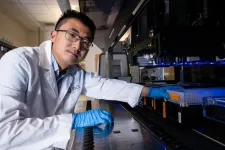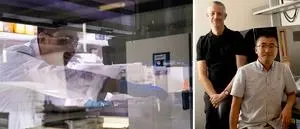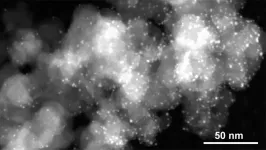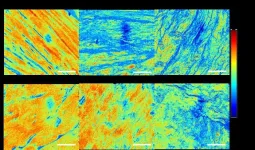(Press-News.org) HOUSTON – (Jan. 3, 2025) – Rice University bioengineers have developed a new construction kit for building custom sense-and-respond circuits in human cells. The research, published in the journal Science, represents a major breakthrough in the field of synthetic biology that could revolutionize therapies for complex conditions like autoimmune disease and cancer.
“Imagine tiny processors inside cells made of proteins that can ‘decide’ how to respond to specific signals like inflammation, tumor growth markers or blood sugar levels,” said Xiaoyu Yang, a graduate student in the Systems, Synthetic and Physical Biology Ph.D. program at Rice who is the lead author on the study. “This work brings us a whole lot closer to being able to build ‘smart cells’ that can detect signs of disease and immediately release customizable treatments in response.”
The new approach to artificial cellular circuit design relies on phosphorylation — a natural process cells use to respond to their environment that features the addition of a phosphate group to a protein. Phosphorylation is involved in a wide range of cellular functions, including the conversion of extracellular signals into intracellular responses — e.g., moving, secreting a substance, reacting to a pathogen or expressing a gene.
In multicellular organisms, phosphorylation-based signaling often involves a multistage, cascading effect like falling dominoes. Previous attempts at harnessing this mechanism for therapeutic purposes in human cells have focused on re-engineering native, existing signaling pathways. However, the complexity of the pathways makes them difficult to work with, so applications have remained fairly limited.
Thanks to Rice researchers’ new findings, however, phosphorylation-based innovations in “smart cell” engineering could see a significant uptick in the coming years. What enabled this breakthrough was a shift in perspective:
Phosphorylation is a sequential process that unfolds as a series of interconnected cycles leading from cellular input (i.e. something the cell encounters or senses in its environment) to output (what the cell does in response). What the research team realized — and set out to prove — was that each cycle in a cascade can be treated as an elementary unit, and these units can be linked together in new ways to construct entirely novel pathways that link cellular inputs and outputs.
“This opens up the signaling circuit design space dramatically,” said Caleb Bashor, an assistant professor of bioengineering and biosciences and corresponding author on the study. “It turns out, phosphorylation cycles are not just interconnected but interconnectable — this is something that we were not sure could be done with this level of sophistication before.
“Our design strategy enabled us to engineer synthetic phosphorylation circuits that are not only highly tunable but that can also function in parallel with cells’ own processes without impacting their viability or growth rate.”
While this may sound straightforward, figuring out the rules for how to build, connect and tune the units — including the design of intra- and extracellular outputs — was anything but. Moreover, the fact that synthetic circuits could be built and implemented in living cells was not a given.
“We didn’t necessarily expect that our synthetic signaling circuits, which are composed entirely of engineered protein parts, would perform with a similar speed and efficiency as natural signaling pathways found in human cells,” Yang said. “Needless to say, we were pleasantly surprised to find that to be the case. It took a lot of effort and collaboration to pull it off.”
The do-it-yourself, modular approach to cellular circuit design proved capable of reproducing an important systems-level ability of native phosphorylation cascades, namely amplifying weak input signals into macroscopic outputs. Experimental observations of this effect verified the team’s quantitative modelling predictions, reinforcing the new framework’s value as a foundational tool for synthetic biology.
Another distinct advantage of the new approach to sense-and-respond cellular circuit design is that phosphorylation occurs rapidly in only seconds or minutes, so the new synthetic phospho-signaling circuits could potentially be programmed to respond to physiological events that occur on a similar timescale. In contrast, many previous synthetic circuit designs were based on different molecular processes such as transcription, which can take many hours to activate.
The researchers also tested the circuits for sensitivity and ability to respond to external signals like inflammatory factors. To prove its translational potential, the team used the framework to engineer a cellular circuit that can detect these factors and could be used to control autoimmune flare-ups and reduce immunotherapy-associated toxicity.
“Our research proves that it is possible to build programmable circuits in human cells that respond to signals quickly and accurately, and it is the first report of a construction kit for engineering synthetic phosphorylation circuits,” said Bashor, who also serves as deputy director for the Rice Synthetic Biology Institute, which was launched earlier this year in order to capitalize on Rice’s deep expertise in the field and catalyze collaborative research.
Caroline Ajo-Franklin, who serves as institute director, said the study’s findings are an example of the transformative work Rice researchers are doing in synthetic biology.
“If in the last 20 years synthetic biologists have learned how to manipulate the way bacteria gradually respond to environmental cues, the Bashor lab’s work vaults us forward to a new frontier — controlling mammalian cells’ immediate response to change,” said Ajo-Franklin, a professor of biosciences, bioengineering, chemical and biomolecular engineering and a Cancer Prevention and Research Institute of Texas Scholar.
The research reported in this press release was supported by the National Institutes of Health (R01EB029483, R01EB032272, R21NS116302, 5R35GM119461), the Office of Naval Research (N00014-21-1-4006), the Robert J. Kleberg Jr. and Helen C. Kleberg Foundation, the Claire Glassell Pediatric Fund, the Grace Reynolds Wall Research Fund and the National Science Foundation (1842494). The content herein is solely the responsibility of the authors and does not necessarily represent the official views of the funding organizations and institutions.
-30-
This news release can be found online at news.rice.edu.
Follow Rice News and Media Relations via Twitter @RiceUNews.
Peer-reviewed paper:
"Engineering synthetic phosphorylation signaling networks in human cells" | Science | DOI: 10.1126/science.adm8485
Authors: Xiaoyu Yang, Jason Rocks, Kaiyi Jiang, Andrew Walters, Kshitij Rai, Jing Liu, Jason Nguyen, Scott Olson, Pankaj Mehta, James Collins, Nichole Daringer and Caleb Bashor
https://doi.org/10.1126/science.adm8485
Access associated media files:
https://rice.box.com/s/0alhd3u6k8ifxx0wdkzpmrtb8ahg4cle (Photos by Jeff Fitlow/Rice University)
About Rice:
Located on a 300-acre forested campus in Houston, Texas, Rice University is consistently ranked among the nation’s top 20 universities by U.S. News & World Report. Rice has highly respected schools of architecture, business, continuing studies, engineering and computing, humanities, music, natural sciences and social sciences and is home to the Baker Institute for Public Policy. Internationally, the university maintains the Rice Global Paris Center, a hub for innovative collaboration, research and inspired teaching located in the heart of Paris. With 4,776 undergraduates and 4,104 graduate students, Rice’s undergraduate student-to-faculty ratio is just under 6-to-1. Its residential college system builds close-knit communities and lifelong friendships, just one reason why Rice is ranked No. 1 for lots of race/class interaction and No. 7 for best-run colleges by the Princeton Review. Rice is also rated as a best value among private universities by the Wall Street Journal and is included on Forbes’ exclusive list of “New Ivies.”
END
Major breakthrough for ‘smart cell’ design
Rice lab pioneers assembly kit for synthetic sense-and-respond circuits in human cells
2025-01-03
ELSE PRESS RELEASES FROM THIS DATE:
From CO2 to acetaldehyde: Towards greener industrial chemistry
2025-01-03
Acetaldehyde is a vital chemical used in making everything from perfumes to plastics. Today, its production largely relies on ethylene, a petrochemical. But increasing environmental concerns are pushing the chemical industry to reduce its reliance on fossil fuels, so scientists have been searching for greener ways to produce acetaldehyde.
Currently, acetaldehyde is produced through the so-called “Wacker process”, a chemical synthesis method that uses ethylene from oil and natural gas with other chemicals such as strong acids, i.e. hydrochloric acid. The Wacker process not only has a large carbon footprint ...
Unlocking proteostasis: A new frontier in the fight against neurodegenerative diseases like Alzheimer's
2025-01-03
Scientists have uncovered a powerful ally in the fight against neurodegenerative diseases: a nucleolar complex that plays a pivotal role in maintaining cellular health through protein homeostasis (proteostasis), by which cells maintain the balance and proper functioning of their proteins. By suppressing this complex, researchers have shown it’s possible to dramatically reduce the toxic effects of Alzheimer’s-causing proteins, boosting the cell’s natural defenses through enhanced degradation of hazardous proteins. This mechanism regulates proteostasis across tissues by modulating TGF-β signaling, a pathway involved in cell growth, differentiation, ...
New nanocrystal material a key step toward faster, more energy-efficient computing
2025-01-03
CORVALLIS, Ore. – Scientists including an Oregon State University chemistry researcher have taken a key step toward faster, more energy-efficient artificial intelligence, and data processing in general, with the discovery of luminescent nanocrystals that can be quickly toggled from light to dark and back again.
“The extraordinary switching and memory capabilities of these nanocrystals may one day become integral to optical computing – a way to rapidly process and store information using light particles, which travel faster than anything in the ...
One of the world’s largest social programs greatly reduced tuberculosis among the most vulnerable
2025-01-03
Brazil’s Bolsa Família Program (BFP), one of the world’s largest conditional cash transfer programmes, was responsible for the reduction of more than half the number of tuberculosis cases and deaths among those living in extreme poverty and indigenous groups, shows a large study coordinated by the Barcelona Institute for Global Health (ISGlobal), a centre supported by “la Caixa” Foundation, the Institute of Collective Health, and the CIDACS-FIOCRUZ in Bahia, Brazil. The findings, published in Nature ...
Surprising ‘two-faced’ cancer gene role supports paradigm shift in predicting disease
2025-01-03
UNDER STRICT EMBARGO UNTIL 10AM (UK TIME) FRIDAY 3 JANUARY 2025.
Peer reviewed | Observational study | Cells
A genetic fault long believed to drive the development of oesophageal cancer may in fact play a protective role early in the disease, according to new research published in Nature Cancer. This unexpected discovery could help doctors identify which individuals are at greater risk of developing cancer, potentially leading to more personalised and effective preventive strategies.
“We ...
Growing divide: Agricultural climate policies affect food prices differently in poor and wealthy countries
2025-01-03
“In high-income countries like the U.S. or Germany, farmers receive less than a quarter of food spending, compared to over 70 percent in Sub-Saharan Africa, where farming costs make up a larger portion of food prices,” says David Meng-Chuen Chen, PIK scientist and lead author of the study published in Nature Food. “This gap underscores how differently food systems function across regions.” The researchers project that as economies develop and food systems industrialise, farmers will increasingly receive a smaller share of consumer spending, a measure known as the ‘farm ...
New approaches against metastatic breast cancer: mini-tumors from circulating cancer cells
2025-01-03
Tumor cells circulating in the blood are the “germ cells” of breast cancer metastases. They are very rare and could not be propagated in the culture dish until now, which made research into therapy resistance difficult. A team from the German Cancer Research Center (DKFZ), the Heidelberg Stem Cell Institute HI-STEM* and the NCT Heidelberg** has now succeeded for the first time in cultivating stable tumor organoids directly from blood samples of breast cancer patients. Using these mini-tumors, the researchers ...
Loneliness linked to higher risk of heart disease and stroke and susceptibility to infection
2025-01-03
Interactions with friends and family may keep us healthy because they boost our immune system and reduce our risk of diseases such as heart disease, stroke and type 2 diabetes, new research suggests.
Researchers from the UK and China drew this conclusion after studying proteins from blood samples taken from over 42,000 adults recruited to the UK Biobank. Their findings are published today in the journal Nature Human Behaviour.
Social relationships play an important role in our wellbeing. Evidence increasingly ...
Some bacteria evolve like clockwork with the seasons
2025-01-03
Like Bill Murray in the movie “Groundhog Day,” bacteria species in a Wisconsin lake are in a kind of endless loop that they can’t seem to shake. Except in this case, it’s more like Groundhog Year.
According to a new study in Nature Microbiology, researchers found that through the course of a year, most individual species of bacteria in Lake Mendota rapidly evolved, apparently in response to dramatically changing seasons. Gene variants would rise and fall over generations, yet hundreds of separate species would return, almost fully, to near copies of what they had been genetically prior to a thousand or so generations of evolutionary pressures. (Individual microbes ...
New imaging technique offers insight into Achilles tendon injury recovery
2025-01-03
Achilles tendon injuries are common but challenging to monitor during recovery due to the limitations of current imaging techniques. Researchers, led by Associate Professor Zeng Nan from the International Graduate School at Shenzhen, Tsinghua University, have applied Mueller matrix polarimetry, a non-invasive imaging method, to more accurately observe and evaluate the healing of Achilles tendon injuries. This technique offers unique insights by capturing the subtle changes in tendon tissue without needing labels or dyes, allowing for more natural tissue characterization.
The study used Mueller ...
LAST 30 PRESS RELEASES:
Reducing social isolation protects the brain in later life
Keeping the heart healthy increases longevity even after cancer
Young adults commonly mix cannabis with nicotine and tobacco
Comprehensive review illuminates tau protein's dual nature in brain health, disease, and emerging psychiatric connections
Book prepares K-12 leaders for the next public health crisis
Storms in the Southern Ocean mitigates global warming
Seals on the move: Research reveals key data for offshore development and international ecology
Sports injuries sustained during your period might be more severe
World's first successful 2 Tbit/s free-space optical communication using small optical terminals mountable on satellites and HAPS
Can intimate relationships affect your heart? New study says ‘yes’
Scalable and healable gradient textiles for multi‑scenario radiative cooling via bicomponent blow spinning
Research shows informed traders never let a good climate crisis go to waste
Intelligent XGBoost framework enhances asphalt pavement skid resistance assessment
Dual-function biomaterials for postoperative osteosarcoma: Tumor suppression and bone regeneration
New framework reveals where transport emissions concentrate in Singapore
NTP-enhanced lattice oxygen activation in Ce-Co catalysts for low-temperature soot combustion
Synergistic interface engineering in Cu-Zn-Ce catalysts for efficient CO2 hydrogenation to methanol
COVID-19 leaves a lasting mark on the human brain
Scientists use ultrasound to soften and treat cancer tumors without damaging healthy tissue
Community swimming program for Black youth boosts skills, sense of belonging, study finds
Specific depressive symptoms in midlife linked to increased dementia risk
An ‘illuminating’ design sheds light on cholesterol
Who is more likely to get long COVID?
Study showcases resilience and rapid growth of “living rocks”
Naval Research Lab diver earns Office of Naval Research 2025 Sailor of the Year
New Mayo-led study establishes practical definition for rapidly progressive dementia
Fossil fuel industry’s “climate false solutions” reinforce its power and aggravate environmental injustice
Researchers reveal bias in a widely used measure of algorithm performance
Alcohol causes cancer. A study from IOCB Prague confirms damage to DNA and shows how cells defend against it
Hidden viruses in wastewater treatment may shape public health risks, study finds
[Press-News.org] Major breakthrough for ‘smart cell’ designRice lab pioneers assembly kit for synthetic sense-and-respond circuits in human cells






